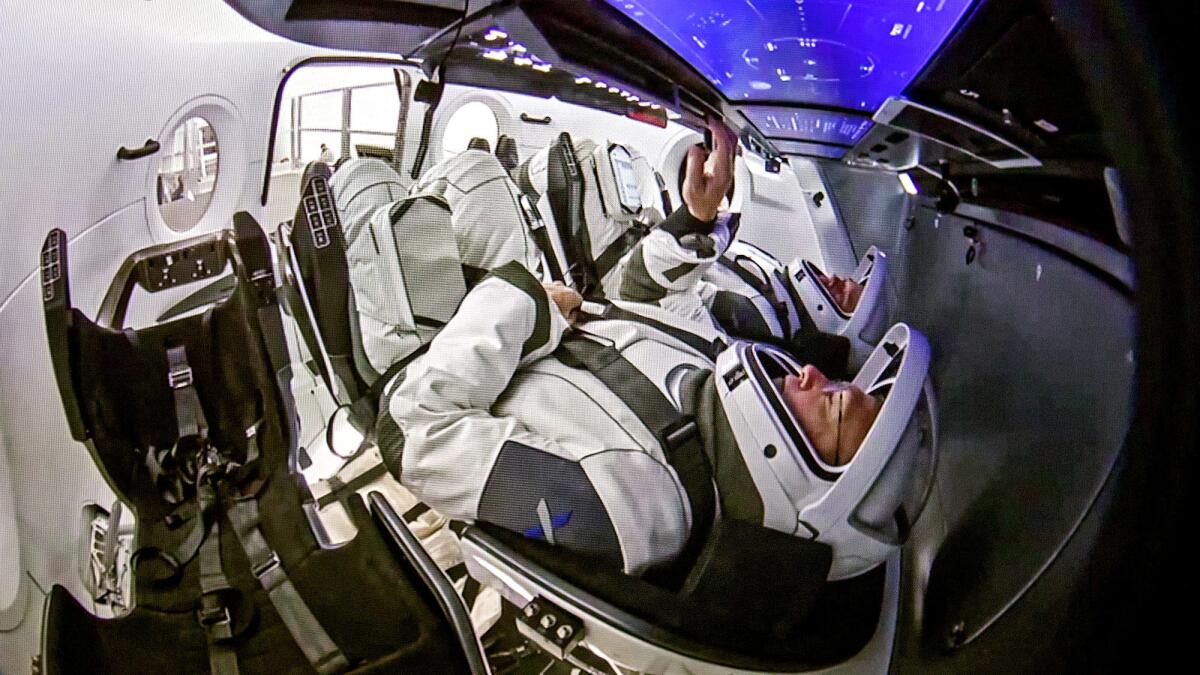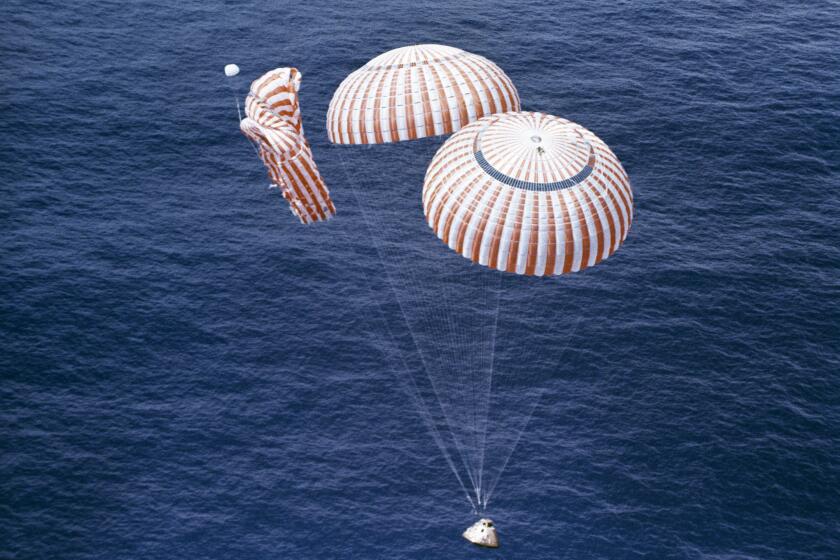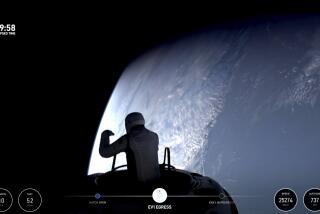SpaceX is launching its first human crew to space Saturday. How coronavirus affected preparations

- Share via
NASA astronauts Bob Behnken and Doug Hurley have trained for years for this moment.
They spent, at minimum, hundreds of hours learning the intricacies of the SpaceX capsule they’ll ride to the International Space Station. And they got used to the craft’s touch-screen flight system, a major change from the 2,000 switches and circuit breakers used to fly the space shuttle.
Soon, all of that preparation will be put to the test.
Behnken and Hurley will be the first people ever to launch in SpaceX’s Crew Dragon capsule. During that test flight, which because of Wednesday’s weather is now slated for liftoff from Florida on Saturday at 3:22 p.m. EDT, the astronauts will make sure all the systems work before NASA certifies the spacecraft to regularly transport its astronauts to the space station.
But just two months before the mission, during a time when they were learning crucial skills for everyday space-station living, the coronavirus outbreak hit. Without close, interpersonal training, it can be hard to learn those routine tasks, like using — and fixing — the complex piece of machinery that is the station’s toilet.
“You want to be able to do the things you’re going to have to do every day without having to think too much about them,” said Peggy Whitson, a former NASA astronaut who retired in 2018. “Those are the things that are going to waste time if you aren’t pretty familiar going in.”
There’s already a lot riding on this mission.
Saturday’s launch is the first time NASA astronauts will launch to orbit from U.S. soil since the space shuttle was retired in 2011.
If the mission is successful, NASA will no longer have to rely solely on Russia to transport U.S. astronauts to space, which has cost the U.S. billions of dollars.
It would also bolster NASA’s bet that relying on commercial companies for “routine” services, such as transporting cargo and crew to the space station, will free up the agency to focus on more ambitious endeavors, such as missions to the moon or Mars.
“The expectation after Apollo was that we’d be on Mars by 1980,” said Lori Garver, who was NASA’s deputy administrator from 2009 to 2013. “Finally, I think, we’re going to be able to accelerate our progress by opening it up, reducing the cost.”
For SpaceX, a successful launch would achieve the company’s long-standing goal of sending humans into space. It also signifies how much the company has evolved over its 18 years.
When SpaceX and Boeing Co. were awarded multibillion contracts in 2014 to develop separate spacecraft to ferry astronauts to the space station, the Elon Musk-led SpaceX was seen as a scrappy upstart. Today, the company has an extensive list of customers ranging from commercial satellite operators to the U.S. military and, of course, NASA.
“They build and operate what I consider to be safe spacecraft,” said former NASA Administrator Charles Bolden Jr., who was initially unimpressed with SpaceX after a visit early in the company’s history. “They have grown in my estimation and my personal esteem, in no small part due to their leadership in the form of Gwynne Shotwell.”
Even SpaceX and Boeing, which have accomplished great engineering feats, are still grappling with the tech.
Shotwell, the company’s president and chief operating officer, said earlier this month that there are thousands of SpaceX employees focused on this mission.
“We spent years working on this vehicle,” she told reporters. “There will be a little sense of relief once [Behnken and Hurley are] in orbit. I’ll feel more relief when they get to the station and then, obviously, I will start sleeping again when they’re back safely on the planet.”
In March, as the COVID-19 pandemic continued to spread, NASA had to evaluate the astronauts’ remaining training sessions and decide which had to be done in-person, with as few people as possible, and which could be held remotely.
Learning how to use the space station’s kitchen equipment? Virtual.
Instructors used photos and videos to show Behnken and Hurley how to warm up food and figure out how much water they’d need to rehydrate their food packages.
Practicing space walks? In person.
Behnken suited up in a replica of the spacesuit he’d wear during an actual spacewalk and scaled a life-size space station mock-up that sits in a 40-foot-deep pool at Houston’s Johnson Space Center.
The 20 or so experts who usually congregate in a nearby conference room to answer questions or give tips watched from home and relied on video communications, said Megan Levins, chief training officer at Johnson Space Center.
Learning how to use the space station’s toilet? Definitely an in-person lesson.
“It’s hardware you want to make sure you know how to use,” Levins said.
The station’s waste management system is high-tech and involves buttons, switches and a number of parts. There are pumps and compressors. There’s a suction function that pulls urine into a funnel and runs it through an air/water separator. Suction is also needed to perform the vital task of pulling solid waste into the toilet. (“In zero gravity, everything floats,” Whitson said.)
That’s why it’s so important to know exactly how to set up the toilet, use it and figure out if there’s a problem.
Usually, astronauts will train side-by-side with an instructor, who uses a mock-up of the toilet to show them how to manipulate its valves. This time, the instructor stood more than six feet away, wore a mask and gave verbal instructions to the astronauts at the mock-up toilet.
It’s less efficient to explain everything verbally, Levin said. “It is more difficult but doable.”
NASA has plenty of experience isolating staff to stave off illness.
Decades before the COVID-19 pandemic, NASA established strict rules to keep astronauts from getting sick before they launched into space and potentially infected others in their close living quarters.
And in the early days of the space program, astronauts were sequestered once they returned home. Famously, Apollo 11 astronauts Neil Armstrong, Buzz Aldrin and Michael Collins were quarantined for three weeks after their moon mission in 1969 for fear of lunar contagions.
Nowadays, astronauts typically enter quarantine two weeks before launch and get their temperatures checked every day, said Whitson, who is also a former chief of NASA’s astronaut office. During this period, only a few peoplesuch as spouses or those crucial to the mission are allowed to visit the crew.
“We’ve never used the term ‘social distance’ ... but that’s exactly what we were doing,” she said. “We have one integrated ventilation system onboard. If one person gets sick, everybody’s going to get sick.”
For Behnken, the additional measures put in place were just an extension of what he was already used to as a veteran astronaut and former chief of NASA’s astronaut office.
“We assume pandemic for all crews that are headed toward the space station,” he said. “We just have been doing that longer.”
On Earth, particles from a sneeze might travel six feet. But in space, those particles can stay in the air for much longer, though they will eventually get filtered out through the station’s ventilation system, Whitson said.
“Everything is going to be in your face,” she said.
More to Read
Inside the business of entertainment
The Wide Shot brings you news, analysis and insights on everything from streaming wars to production — and what it all means for the future.
You may occasionally receive promotional content from the Los Angeles Times.












